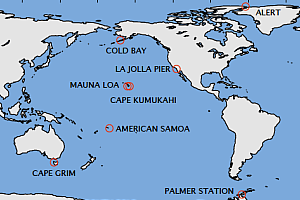More Charts Available (CC attribute) using menu upper right on 2° Institute site.

How fast is the O2concentration of the atmosphere decreasing?
Measurements from the Scripps O2 Program show that from January 1992 to January 2009, the O2 concentration under unpolluted conditions at La Jolla decreased by 320 per meg. This corresponds to a loss of 320 O2molecules out of each one million O2 molecules in the atmosphere, or a loss of 0.032 %. Dividing by 17 years yields an average loss rate per year of 19 per meg or 0.0019 % per year. The decrease measured at other stations in our network is very similar, showing that the trend is global.
Sources: https://www.oxygenlevels.org/#sources
AN INVENTORY OF EARTH’S OXYGEN LEVELS.
Data Sources

SCRIPPS O2 PROGRAM
Changes in atmospheric oxygen levels are measured at the Scripps Institution of Oceanography at La Jolla, California under the Scripps O2 Program. Since 1991, air samples have been collected on a consistent basis from stations around the world to provide a global and hemispheric perspective on oxygen variability. The Scripps O2 Program is under the direction of Professor Ralph Keeling.
The Scripps Institute report oxygen measurements as changes in the O2/N2 ratio of air relative to a reference. They compute:
δ = ((O2/N2)sample – (O2/N2)reference)/ (O2/N2)reference)
where (O2/N2)sample is the O2/N2 mole ratio of an air sample and (O2/N2)reference is the O2/N2 mole ratio of their reference. Their reference is based on tanks of air pumped in the mid 1980s which are stored at the Scripps Institute laboratory in La Jolla, California.
Learn more about units and terms here or get answers to frequently asked questions by accessing the graph menu above.
You may enjoy this software for free under a Creative Commons (CC) Attribution-NonCommercial licence.